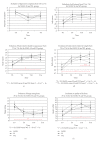Psychological Impact of a "Health-at-Every-Size" Intervention on Weight-Preoccupied Overweight/Obese Women
- PMID: 20798861
- PMCID: PMC2925467
- DOI: 10.1155/2010/928097
Psychological Impact of a "Health-at-Every-Size" Intervention on Weight-Preoccupied Overweight/Obese Women
Abstract
The aim of the present study was to assess the impact of a "Health-at-every-size" (HAES) intervention on psychological variables and body weight the weight-preoccupied overweight/obese women. Those women were randomized into three groups (1) HAES, (2) social support (SS), (3) waiting-list (WL), and were tested at baseline, post-treatment and six-month and one-year follow-ups. All participants presented significant psychological improvement no matter if they received the HAES intervention or not. However, even if during the intervention, the three groups showed improvements, during the follow up, the HAES group continued to improve while the other groups did not, even sometimes experiencing some deterioration. Furthermore, in the HAES group only, participant's weight maintenance 12 months after the intervention was related to their psychological improvement (quality of life, body dissatisfaction, and binge eating) during the intervention. Thus, even if, in the short-term, our study did not show distinctive effects of the HAES intervention compared to SS and WL on all variables, in the long-term, HAES group seemed to present a different trajectory as psychological variables and body weight are maintained or continue to improve, which was not the case in other groups. These differential long-term effects still need to be documented and further empirically demonstrated.
Figures
Similar articles
-
Effects of health at every size based interventions on health-related outcomes and body mass, in a short and a long term.Front Nutr. 2024 Oct 8;11:1482854. doi: 10.3389/fnut.2024.1482854. eCollection 2024. Front Nutr. 2024. PMID: 39439526 Free PMC article. Review.
-
A Health at Every Size intervention improves intuitive eating and diet quality in Canadian women.Clin Nutr. 2017 Jun;36(3):747-754. doi: 10.1016/j.clnu.2016.06.008. Epub 2016 Jun 18. Clin Nutr. 2017. PMID: 27378611
-
Health-At-Every-Size and eating behaviors: 1-year follow-up results of a size acceptance intervention.J Am Diet Assoc. 2009 Nov;109(11):1854-61. doi: 10.1016/j.jada.2009.08.017. J Am Diet Assoc. 2009. PMID: 19857626 Clinical Trial.
-
Effects of a new intervention based on the Health at Every Size approach for the management of obesity: The "Health and Wellness in Obesity" study.PLoS One. 2018 Jul 6;13(7):e0198401. doi: 10.1371/journal.pone.0198401. eCollection 2018. PLoS One. 2018. PMID: 29979699 Free PMC article. Clinical Trial.
-
Effects of health at every size® interventions on health-related outcomes of people with overweight and obesity: a systematic review.Obes Rev. 2018 Dec;19(12):1659-1666. doi: 10.1111/obr.12749. Epub 2018 Sep 27. Obes Rev. 2018. PMID: 30261553
Cited by
-
The Health at Every Size paradigm and obesity: missing empirical evidence may help push the reframing obesity debate forward.Am J Public Health. 2015 May;105(5):e38-42. doi: 10.2105/AJPH.2015.302552. Epub 2015 Mar 19. Am J Public Health. 2015. PMID: 25790393 Free PMC article.
-
"Now I Can Do Better": A Study of Obese Women's Experiences Following a Nonprescriptive Nutritional Intervention.Clin Med Insights Womens Health. 2015 Sep 13;8:13-24. doi: 10.4137/CMWH.S23163. eCollection 2015. Clin Med Insights Womens Health. 2015. PMID: 26417206 Free PMC article.
-
Effects of health at every size based interventions on health-related outcomes and body mass, in a short and a long term.Front Nutr. 2024 Oct 8;11:1482854. doi: 10.3389/fnut.2024.1482854. eCollection 2024. Front Nutr. 2024. PMID: 39439526 Free PMC article. Review.
-
Intuitive eating longitudinally predicts better psychological health and lower use of disordered eating behaviors: findings from EAT 2010-2018.Eat Weight Disord. 2021 Feb;26(1):287-294. doi: 10.1007/s40519-020-00852-4. Epub 2020 Jan 31. Eat Weight Disord. 2021. PMID: 32006391 Free PMC article.
-
Adherence to Hunger Training over 6 Months and the Effect on Weight and Eating Behaviour: Secondary Analysis of a Randomised Controlled Trial.Nutrients. 2017 Nov 17;9(11):1260. doi: 10.3390/nu9111260. Nutrients. 2017. PMID: 29149038 Free PMC article. Clinical Trial.
References
-
- Doucet E, Imbeault P, St-Pierre S, et al. Appetite after weight loss by energy restriction and a low-fat diet-exercise follow-up. International Journal of Obesity. 2000;24(7):906–914. - PubMed
-
- Polivy J. Psychological consequences of food restriction. Journal of the American Dietetic Association. 1996;96(6):589–592. - PubMed
-
- Chaput J-P, Drapeau V, Hetherington M, Lemieux S, Provencher V, Tremblay A. Psychobiological effects observed in obese men experiencing body weight loss plateau. Depression and Anxiety. 2006;24(7):518–521. - PubMed
-
- Garner DM, Wooley SC. Confronting the failure of behavioral and dietary treatments for obesity. Clinical Psychology Review. 1991;11(6):729–780.
LinkOut - more resources
Full Text Sources
Medical



